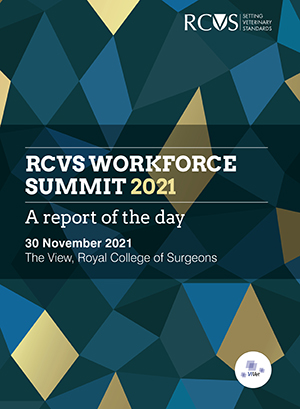New report outlines preliminary findings from Workforce Summit
28 February 2022
The RCVS has released a report, which includes sections on the Design Thinking process, idea formation and potential solutions to the workforce crisis that were discussed at last year’s Workforce Summit. The event was held on 30 November under the auspices of the RCVS ViVet innovation programme, and had 80 stakeholders from across the veterinary industry in attendance looking at how the veterinary professions could work together on the crisis.
 Prior to the Summit, preliminary research had been carried out to assess the professions’ views on the workforce crisis and how it was impacting them. The findings from the preliminary research helped to guide the format of the day and the themes that were discussed.
Prior to the Summit, preliminary research had been carried out to assess the professions’ views on the workforce crisis and how it was impacting them. The findings from the preliminary research helped to guide the format of the day and the themes that were discussed.
All sections of the veterinary professions were represented at the Summit, with attendees from independent and corporate practices, veterinary schools, charities, government, food hygiene sector, species associations and industry bodies.
Based on findings from the preliminary research, six key themes around the issue of workforce shortages were identified and used to structure the discussions of the day. These were: readiness for work; work-life balance; workplace culture; client interactions; career development; and return to work.
The day opened with Lizzie Lockett, RCVS Chief Executive, outlining the importance of having all areas of the veterinary profession represented at the Summit.
Stressing the collaborative nature of the event, she focused on the issues underpinning the workforce crisis, which were:
- ‘Recruitment’; despite the number of vet schools and the annual number of veterinary graduates, there were still not enough vets and vet nurses to fill the demand for veterinary services.
- ‘Retention’; high numbers of vets and vet nurses were leaving the profession every year, with many citing unsociable working hours and stress, among other factors.
- ‘Return’; there were significant numbers of vets and vet nurses who had left the profession who could potentially return to it but maybe felt that the culture of the profession may prevent them from doing so.
We want to reiterate that the Summit was the first, albeit an incredibly important, first step in co-creating innovative solutions to workforce shortages.
Kate Richards, RCVS President
Throughout the day, delegates were encouraged to be ‘solutions focused’ and to approach the issues using Design Thinking, a creative problem-solving process that can produce innovative solutions to difficult challenges. Attendees were divided into groups and after discussing the six key themes, were asked to develop ideas and pitch a potential solution to a problem the sector was facing.
Some of the solutions that the professions might use to address the key workforce issues which came out of the pitches included:
- Rebrand the GP role (for both vets and vet nurses) to emphasise its benefits and rewards, which will encourage people to choose general practice as an active career choice that they wished to pursue long term.
- Develop ways for practices to prioritise workload and to ensure that people’s skills are maximised. This could include developing legislation that allows nurses to take on greater responsibility and developing efficiency models which focus on delegation and outsourcing rather than working longer hours.
- Introduce a compulsory curriculum for developing interpersonal, leadership and personal skills to be considered as important as mandatory CPD. This could be achieved through developing a workplace charter and identifying leaders with a passion for personal progression who could spearhead the initiative.
- Create a compulsory communications skills programme which would be introduced in a sustainable way.
- Introduce a professions-wide career framework to help everyone in the veterinary team achieve job satisfaction at the time they wanted it, at a salary that recognised their value and met their needs.
- Create a flexible back-to-work package of support to help them return to the veterinary professions after leaving the Register.
Kate Richards, RCVS President (pictured), said: “I want to thank everyone who attended the Summit and for taking part in robust debates throughout the day. We know that one organisation can’t solve all the issues facing the veterinary workforce, which is why it was so important to have the expertise and experience of numerous people and organisations present at the Summit.
“Although the issues affecting the UK veterinary sector aren’t new, they have been exacerbated over the past few years by factors outside of the sector’s control. We know that putting in place solutions to address and solve the issues that the veterinary sector is facing will take time.
factors outside of the sector’s control. We know that putting in place solutions to address and solve the issues that the veterinary sector is facing will take time.
"We want to reiterate that the Summit was the first, albeit an incredibly important, first step in co-creating innovative solutions to workforce shortages. I look forward to working collaboratively with our veterinary colleagues from across the professions to bring the workforce action plan to life and work on the solutions that come out of it.”
The next follow-on steps from the Summit are to consider the feasibility of the suggested solutions and integrate those that seem likely to deliver effective results into an action plan, alongside other activities that are already underway. Delivery of the plan will be a fully collaborative approach across the professions as we understand that everyone has a part to play in finding and delivering solutions. ViVet is open to hearing additional ideas for the professions and encourages anyone who has suggestions to get in touch with Sophie Rogers, ViVet Manager, on [email protected]
The full Workforce Summit report can be found at www.rcvs.org.uk/publications